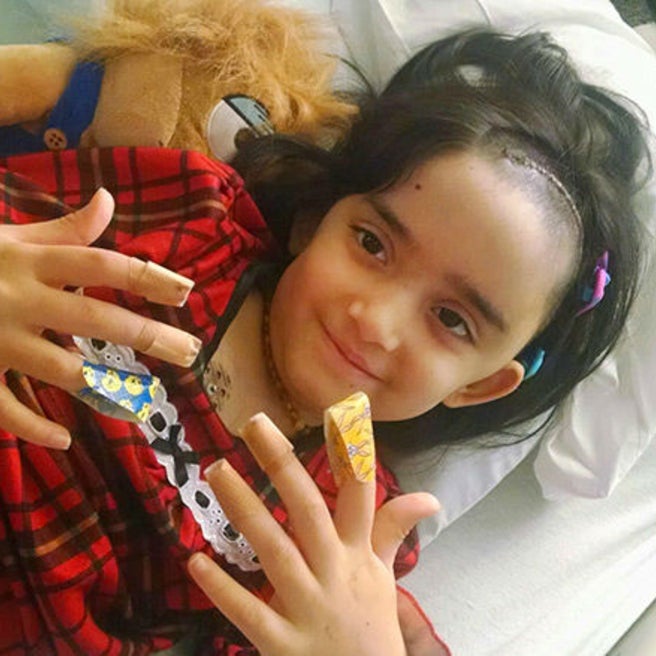Craniopharyngiomas are tumors that are typically found near the pituitary gland and hypothalamus, which are positioned beneath the center of the brain, behind and between the eyes. Craniopharyngiomas are not cancerous, and do not spread to other parts of the brain or to other parts of the body. They are usually a partly solid and partly fluid-filled cyst.
Craniopharyngiomas tend to become attached to the pituitary gland or to nearby tissues, including the optic nerves, the arteries that feed into the brain, and the brain itself. They grow slowly; and as they grow larger, put pressure on nearby tissue. This pressure can cause health problems by interfering with the function of the brain, the pituitary gland, the optic (eye) nerves, or arteries.
Causes of craniopharyngiomas
Craniopharyngiomas have no clear cause. They are thought to form during the development of the brain and pituitary gland, possibly as a remnant of structures that are present in the early stages of the human embryo but normally disappear before birth. The two structures in the embryo thought to play a role in the formation of craniopharyngiomas are the craniopharyngeal duct and Rathke’s pouch.
Signs and symptoms of craniopharyngiomas
Symptoms of craniopharyngiomas typically appear in childhood, usually between the ages of 5 and 14. Symptoms vary widely, depending on the tumor’s size and location.
If the tumor is putting pressure on the brain, symptoms may include:
- Headache
- Nausea and vomiting
- Balance problems or trouble walking
If the tumor is putting pressure on or interfering with the function of the optic nerves, symptoms may include:
- Vision problems, such as double vision or narrowed field of vision
If the tumor is putting pressure on or interfering with the function of the pituitary gland, symptoms may include:
- Slowed growth or short stature
- Excessive thirst and urination
- Delayed puberty
- Low energy, listlessness or unusual sleepiness
- Weight gain
- Changes in personality or behavior
- Intolerance of cold temperatures
Testing and diagnosis for craniopharyngiomas
Your doctor will usually begin with a physical exam and with questions about any symptoms you may have noticed.
- Height and weight will be charted to look for changes in growth patterns.
- The doctor may check for lumps.
If signs indicate the possibility of a pituitary tumor, additional tests may include:
- Neurological exam to check mental status, coordination, reflexes and muscle function
- Eye test to check for loss of vision, including narrowing field of vision
- Blood tests to check for high or low levels of hormones and blood sugar
- Magnetic resonance imaging (MRI) or computerized tomography (CT) scan to get visual images of the pituitary gland, brain and spinal cord, sometimes repeated over time to find out whether or how quickly the tumor is growing
Treatment for craniopharyngiomas
The goal of treatment for craniopharyngiomas is to relieve symptoms. Because the symptoms are generally caused by pressure from the growing tumor on the brain, the optic nerves or the pituitary gland, the way to relieve the symptoms is usually to remove or shrink the tumor.
- Surgery may be done to remove all or most of the tumor. Surgeons may reach the tumor through an incision in the upper lip or at the bottom of the nose (endonasal surgery), or by cutting through the skull. Some children requiring surgery will be treated by our specialized Head and Neck Disorders Program.
- Radiation therapy may be used in some cases to kill tumor cells or shrink the tumor after surgery.
Outlook
For most children and adolescents with craniopharyngiomas, treatment is effective in removing or stopping the growth of the tumor.
Pituitary hormone replacements are managed by experienced pediatric endocrinologists. Treatment may include replacing thyroid hormone, growth hormone, pubertal hormones, adrenal steroids, and desmopressin (DDAVP).
Some damage caused by craniopharyngiomas, such as injury to the optic nerves, the brain or the pituitary gland, may be permanent and will not be relieved by removal or shrinkage of the tumor. In some cases, surgery to remove the tumor could damage the tissue to which the tumor is attached. If the tumor is not completely removed, the condition may return.
For children for whom surgical treatment is effective, ongoing surveillance and lifelong pituitary hormone replacement is the mainstay of therapy.
Follow-up care
Lifelong treatment or follow-up is generally needed.
- If the treatment has removed the tumor, follow-up tests and imaging will be needed periodically to make sure the tumor has not returned.
- Medication to replace hormone production may be needed if the function of the pituitary gland has been damaged by the tumor.
Why choose CHOP?
Children with craniopharyngioma often require care from many pediatric specialties.
The Neuroendocrine Center at Children’s Hospital of Philadelphia offers families a coordinated and multidisciplinary approach to treatment for neuroendocrine disorders. Our team combines the expertise of pediatric endocrinologists, neuro-oncologists, neuro-surgeons, neuro-ophthalmologists, neuro-radiologists and pathologists.
All our team members have vast experience in the treatment of complex neuroendocrine conditions.
Resources to help
Division of Endocrinology and Diabetes Resources
We have gathered resources to help you find answers to your endocrine questions.
Reviewed by Craig Alter, MD, Shana E. McCormack, MD, MTR

